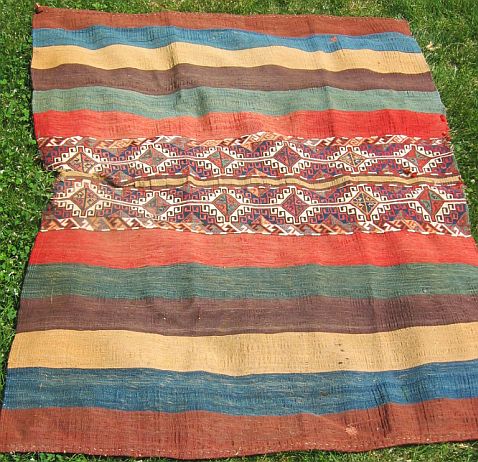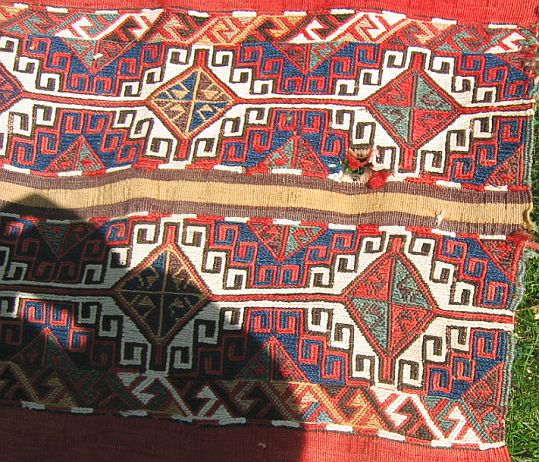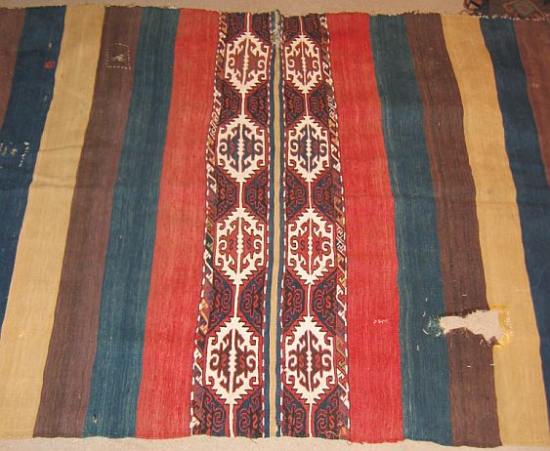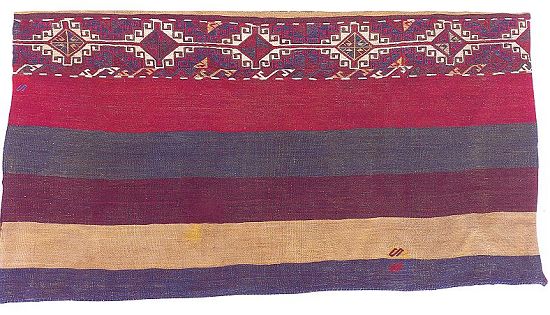Posted by R. John Howe on 05-30-2007 03:20 PM:
A Turkish Chuval of the Non-Grain-Bag Sort
Dear folks
In her catalog "Giving Back the Colors," Josephine Powell
talks about Anatolian kilims and two broad categories of bags.
The first
we've already treated in the "grain bag" thread (their makers call them "dimi
cuval"). But there is a second sort of Turkish bag (actually there is a third
too, but it is seldom interesting aesthetically). This second sort of bag is
used to store bedding, clothing and various household items. They are called
"ala cuval."
The grain bags are quite fine and their designs are
horizontally placed. The "ala cuvals" tend to be somewhat coarser and their
designs are sometimes woven horizontally and sometimes vertically.
I
bought the "ala cuval" below in the Cappadocia area after considering two of
them.

Here
is the brocaded area up closer.

This bag has been used and
there is damage in the brocaded area.
The image below is of one back
panel back a little closer.

This image below is of the other ala cuval I
considered.

It has a brocaded design that seems more dramatic to me, but
less range of color in its striped panels.
The Powell catalog has pieces
the designs of which seem close to both of these two ala cuvals
above.
Here, below, is Powell Plate 238.


The designs on this bag seem
close to those on the one I bought. Powell describes it as "Karakoyunlu," that
is, woven by members of a Yoruk group of that name in southeastern
Anatolia
Powell Plate 272 seems similar to the one I was considering but
decided against.

Powell calls it "Kurdish or Afsar." It was also woven in
southeastern Anatolia.
Bag 6 in the NERS exhibition on bags is another
example of an ala cuval.
http://www.ne-rugsociety.org/gallery/bags/bags-navframe.htm
If
you look down a bit, the NERS description includes photos showing how these bags
are used.
Thoughts and comments are invited.
Regards,
R.
John Howe
Posted by R. John Howe on 06-01-2007 10:04 AM:
Dear folks -
We've talked in the Kyrgyz thread about the visual
judgements we make about colors, especially those we use to indicate whether the
colors of a piece might suggest that its dyes are, at least in part,
synthetic.
One of the checks of this sort we make is to compare the
shades on the front of the piece with those on the back. If the shades on the
back are too much darker (or brighter) we begin to wonder about the dyes in the
piece in question.
With that in mind, look at another photo of this cuval
I bought.

Notice that the red is noticeably more definite on the back of
this piece than it is on the front. The green is quite different,
too.
This bag show signs of having been used and if it was, was likely
exposed to light for extended periods (for example, during migration). It is
known that even natural dyes are not immune to sun burn and would fade some
under such conditions.
It was my considered judgment at purchase that
these color differences are due to exposure to light and not a sign that this
red and this green should be suspected of being synthetics.
But, again,
who knows without chemical test?
This is the kind of decision we
collectors are faced with often as we consider something for purchase. My sense
is that I tend to apply a somewhat looser standard in this regard than do some
experienced collectors. I expect that is, in part, because I do not always see
the likely presence of a synthetic dye as
disqualifying.
Regards,
R. John Howe
Posted by Lars_Jurell on 06-01-2007 01:11 PM:
Hello
The back of your cuval is green and the front seems more blue.
As
green is a mix of blue on yellow yarn or yellow on blue yarn I suppose your
cuval has the green dyed as yellow on blue yarn. And as the cuval front has been
exposed for sun and daily use, the green has turned to blue - the yellow is
gone.
But this is only my guess.
Lars Jurell







